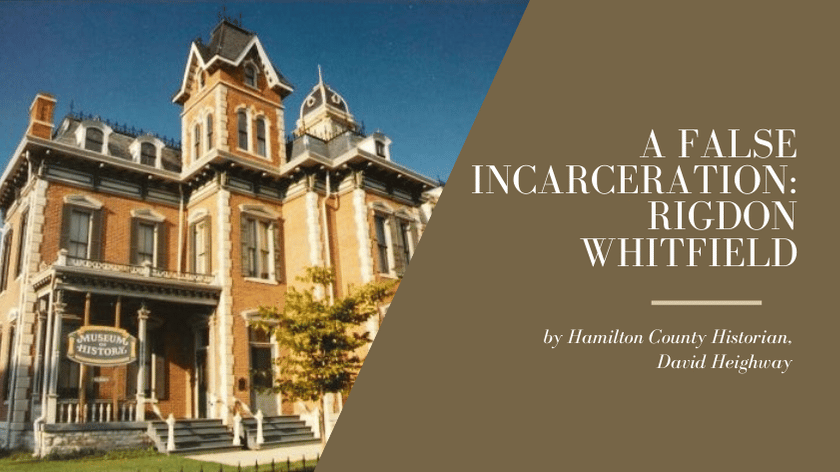 By David Heighway, Hamilton County Historian
By David Heighway, Hamilton County Historian
A topic that many people are discussing these days is the issue of African Americans and a number of apparently unjustified incarcerations. This blog does not comment on modern issues, but it’s interesting to find historic cases that bear some similarities.
One such case started on January 23, 1887, with reports of an “outrageous assault” near Westfield on a woman named Emma Northam, who was described as a “young widow”. The alleged perpetrator was Rigdon Whitfield, an African American man. (His name was often misspelled in the newspaper reports.)
This was reported by newspapers in Illinois and Wisconsin who concluded their articles with the thought that “chances are he will be lynched”. This was echoed by the Indianapolis Journal on January 25 – “The citizens were greatly excited, and talk of lynching was indulged, but wiser counsel prevailed, and Whitfield is now in jail.” This was repeated on January 29 by the local weeklies, the Hamilton County Democrat and the Ledger. The jail where he was kept is now the Hamilton County Historical Society museum. The case was given to Judge David Moss, with prosecutors John F. Neal, Robert Collins, and David W. Patty, and defense attorneys W. S. Christian and Ira W. Christian.
However, apparently not everyone agreed about the story. Evidently, someone was openly questioning it because on February 11, the Democrat reported on the condition of Mrs. Northam and commented, “…there are a few, and but few, persons in this town who will be sorry for some remarks they have made regarding said circumstances…”
A jury trial was held February 21st and 22nd, and Whitfield was found guilty. Some of the jury wanted minimum sentence of 5 years, while others wanted maximum of 21 years. They settled for 13 years. The Ledger made an intriguing statement on March 4, “We were much pleased to note that the jury in the Whitfield trial was made up of white, as well as colored, citizens. Why not give to women the same rights that are accorded to those that are less qualified to execute them?” Local African American barber John Roper was on the petit jury, so this may be referring to him. It’s not clear if the comment was meant to be sarcastic or even possibly derogatory to African Americans and women.
Whitfield was taken to the State Prison at Michigan City, and arrived on March 2. According to the prison records, his occupation was Laborer, he was 54 years old, had a height of 5’ 7”, weighed 172 pounds, was born in North Carolina, had a scar on upper lip, his right forefinger had been broken, and his skull had been fractured. It also said he had his wife Mary and brother Bristow at Westfield, and his mother Eliza at Wilmington, North Carolina.

The story did not end there. On August 30, 1889, the Hamilton County Democrat reported, “The evidence was strongly circumstantial and a petition is now being circulated by his brother asking that he be released. The signatures of several of the parties connected with the trial have been secured and it is likely that a strong appeal will be made.”

Governor Claude Matthews
The response was not immediate. In May of 1892, the Indianapolis papers reported that a petition was being circulated by the original prosecutor, John F. Neal. This was signed by nearly all of the courthouse officials. It eventually reached the governor’s office and Governor Claude Matthews pardoned Whitfield in January of 1894.
In a January 26 article headlined “Justice Too Blind”, the Indianapolis Journal said the reasons were “The alleged victim was a prostitute, and according to Whitefield’s statement, he had furnished her money to go to Marion. She went on a debauch there with two men, and upon her return to Noblesville, Whitfield met her at the station. It was at this time the alleged assault took place, and there was some circumstantial evidence which tended to convict the old man, but which subsequently proved to be of no value.” The Journal called it an “unjust sentence” and said, “He was one of the most faithful men about the prison and was trusted by the officers of the institution.”
It’s unknown what happened to Whitfield after his release. His brother Bristow was listed on the 1880 census as living with his wife and two children in Westfield. However, there is no one named Whitfield in Hamilton County on the 1900 census. Hopefully he was able to live out the rest of his life in peace.
